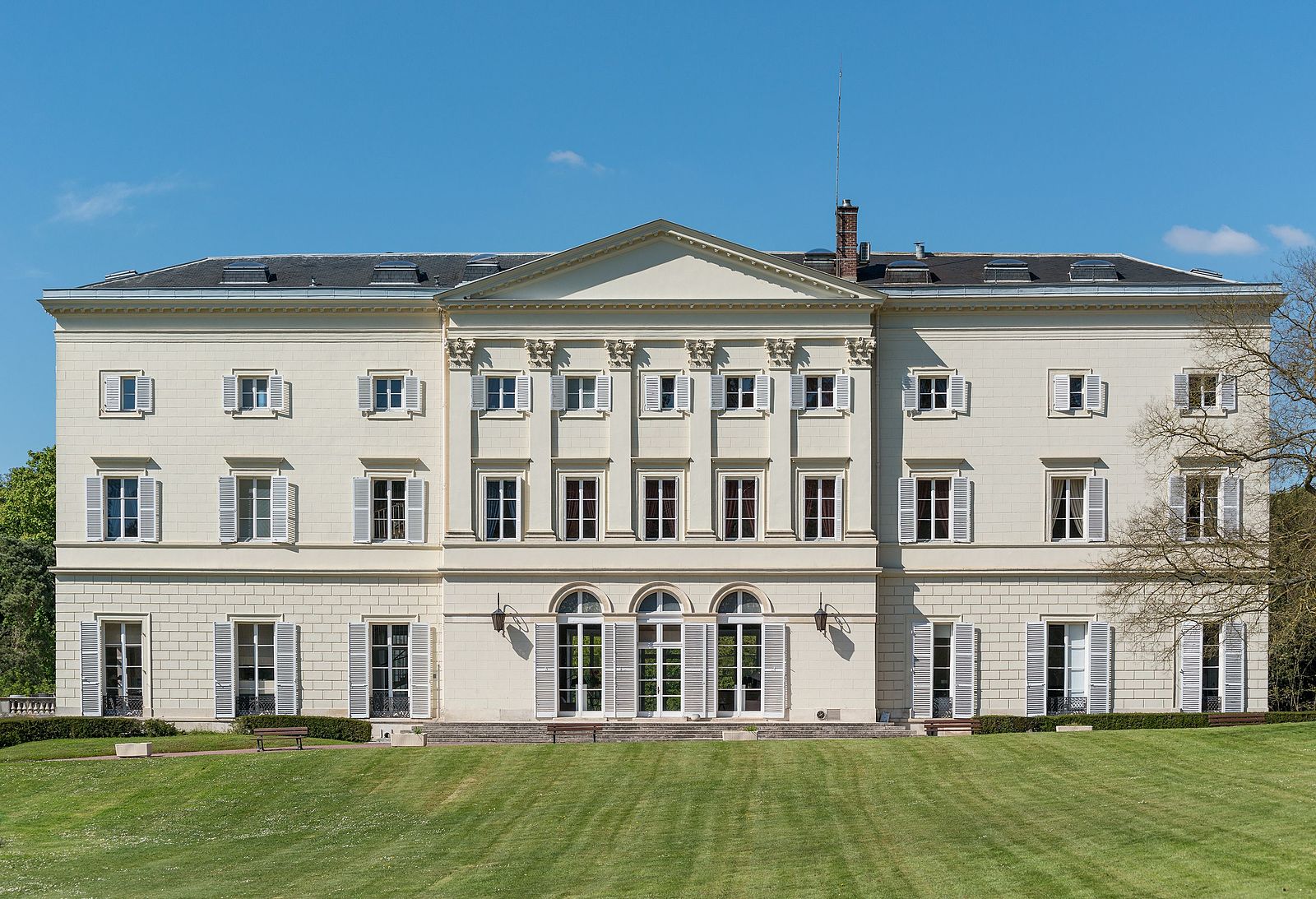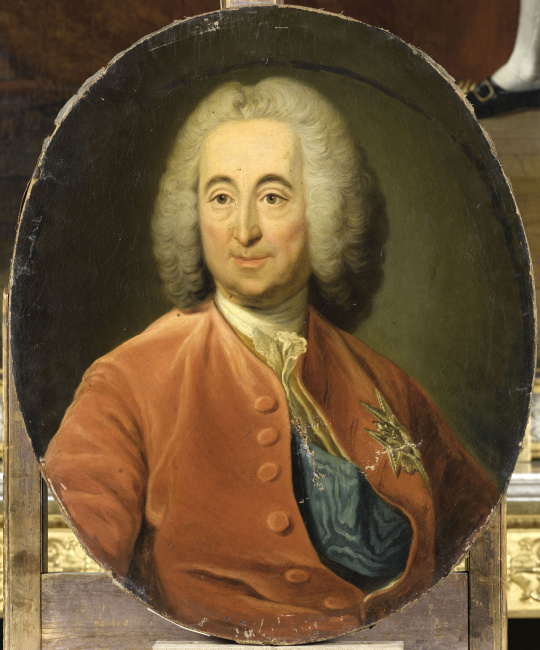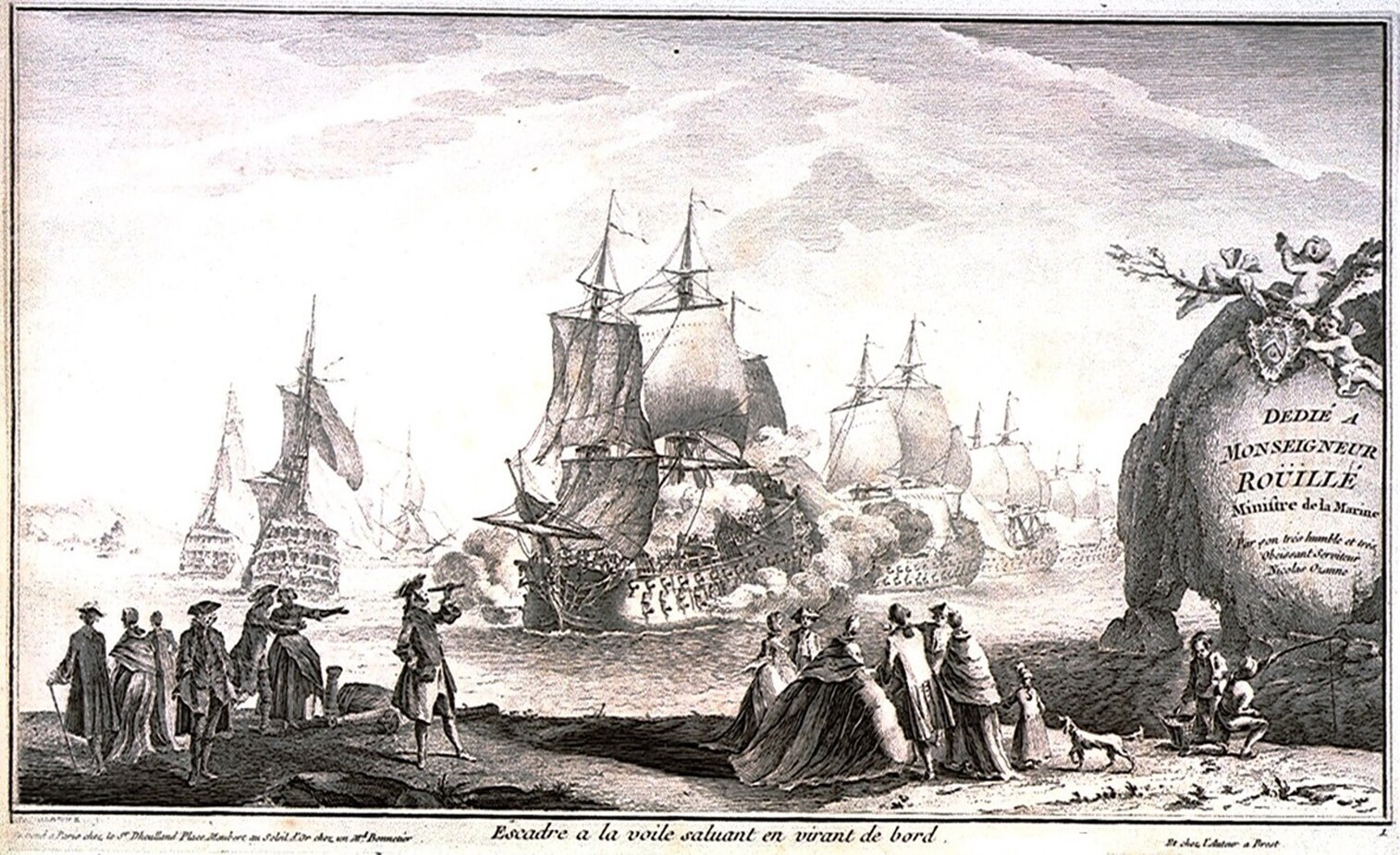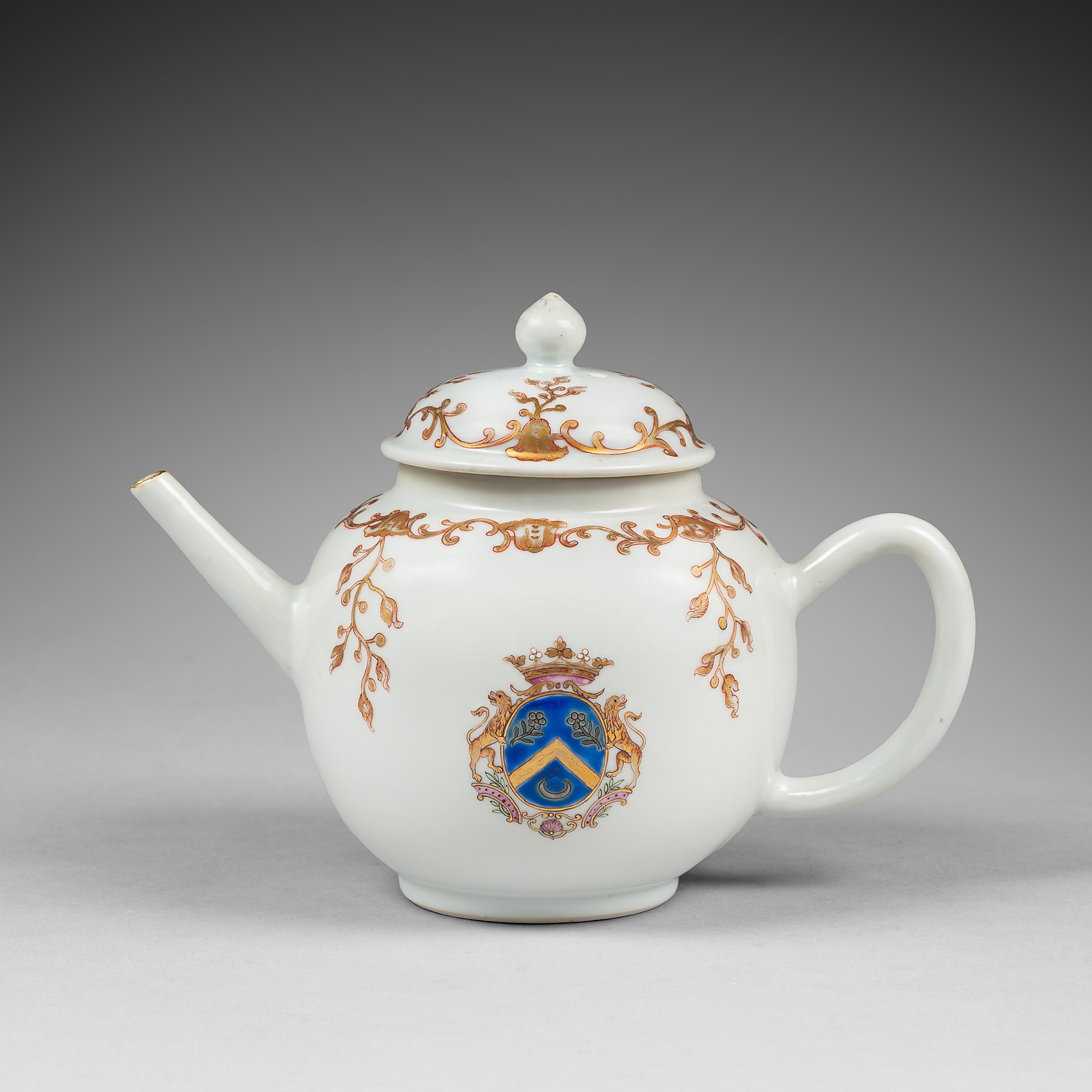Additonal informations :Born in Paris on June 5, 1689, Antoine Louis Rouillé came from a family originally from Touraine. He was the son of Louis-Roslin Rouillé, a counselor of state, and the nephew of Louis Rouillé, the general controller of posts, which was the exclusive and highly lucrative estate of both the Rouillé and Payot families that succeeded each other from 1672 to 1738. His mother was Marie-Angélique d’Aquin, the only daughter of Doctor Louis Henri Antoine d’Aquin, the first physician to Louis XIV. He had acquired the Château de Jouy-en-Josas in 1684. Marie-Angélique married Louis Roslin Rouillé in 1686, to whom the lands and the Château de Jouy-en-Josas were sold in 1701.

Marie-Angélique and Louis gave birth to Antoine-Louis Rouillé in 1689, who would have spent his early years at the Château de Jouy-en-Josas. This castle later became his country residence as he enjoyed an apartment in Versailles and resided in his hotel in Paris, like many of his contemporaries in the service of the King of France. After a brilliant education at a Jesuit school, Antoine-Louis Rouillé became, at the age of 22, a counselor at the Parliament of Paris in 1711, and inherited his father’s fortune in 1712. He would become one of the wealthiest dignitaries at Court, benefiting from an enormous annuity of nearly 200,000 livres per year.
In accordance with the usual career path for high-ranking officials of the time, Antoine-Louis became, from 1718, a Master of Requests at the Council of State. In 1725, he was appointed as the Intendant of Commerce, whose holders, along with the Intendants of Finance, were the primary collaborators of the General Controller of Finances. In this role, he focused particularly on regulating and developing trade with the Levant and encouraging the manufactures of Languedoc, notably by promoting the sending of young people abroad.
In 1732, the Keeper of the Seals, Chauvelin, entrusted Louis-Antoine with the direction of the Librairie, and thus the responsibility for book censorship in the name of the King, a position he held until 1747. He distinguished himself by encouraging the publication of significant works, notably the first fine edition of Molière’s works, and he later maintained close relations with Malesherbes regarding the publication of economically themed works.
Superintendent of the East India Company
Counselor of State in the first half of 1744 and appointed as honorary master of petitions in 1745, Rouillé was nominated that same year to the prominent position of Commissioner of the King to the Perpetual East India Company, which was more than a colonial ministry before its time. It was a very delicate position, especially since France was at war with England—unofficially from 1740 to 1744. The French and English were fiercely competing in India, where the Governor-General of the Company’s establishments at the time was Joseph-François Dupleix. The Company, financed by private capital, had a monopoly on trade with India and enjoyed regal powers (troops, ships, currency, justice), similar to its English rival, the East India Company, founded in 1600, and the Dutch VOC established in 1602. Its objective was to conduct lucrative trade, but it also served as the “armed wing” of the state in this war-torn territory, six months’ journey from France via the perilous “route to India.” Thus, we can see the very delicate role of the Commissioner of the King during this period, which ended in 1748, both in India and in Europe and America, without a decisive victor. Rouillé almost entirely reorganized the French Company.

Secretary of State of the Navy
Thanks to his experience and competence, particularly in economic matters, he was named on April 30, 1749, Secretary of State for the Navy, replacing Jean Frédéric de Maurepas, who had fallen from favor and had held the position since 1723. Initially, Rouillé had refused the post for health reasons, but the king insisted, influenced by Madame de Pompadour and the Controller General of Finances, Machault d’Arnouville. The position was significant as it encompassed not only the navy and its arsenals but also fisheries, consulates, and colonies in America.
Rouillé thus became the minister of New France, which included Canada, with the Great Lakes referred to as the “Pays-d’en-Haut,” and Louisiana, stretching from Illinois to the Gulf of Mexico. Louisiana, administratively separate from Canada since 1717, was under the somewhat theoretical authority of the governor-general and the intendant of New France in Quebec, both of whom reported to the “Minister.” He also oversaw the islands of Guadeloupe, Martinique, and Saint-Domingue, which made France the world’s leading sugar producer due to its plantations populated by enslaved people (150,000 in Saint-Domingue). However, the Indies remained under the control of the East India Company, a state within a state, which reported to the Controller General of Finances.
Rouillé is recognized for wanting to build a learned navy, actively encouraging all sciences related to navigation. He continued with rigor and method the policies of his predecessor in this remarkable quest for discoveries that characterized the Age of Enlightenment. Numerous books and treaties were published in all the diverse fields he was closely interested in, in constant collaboration with the Academy of Sciences. On July 27, 1754, the Marquis de Saint Contest, Secretary of State for Foreign Affairs, suddenly died at the Château de Versailles in front of the king. In his memoirs, the Marquis d’Argenson claimed that more than thirty-five candidates came forward to succeed him. Rouillé, surprised and reluctant, was then offered the position of Secretary of State for Foreign Affairs, undoubtedly because he was well aware of the increasingly tense relations between France and England since the Treaty of Aix-la-Chapelle in 1748. To overcome his hesitations, and according to the Memoirs of the Court of Louis XV by the Duke of Luynes, he was granted a bonus and the right to purchase the prestigious position of Grand Treasurer in the Royal Order of the Holy Spirit, which he bought from Machault for the sum of “300,000 livres and 100,000 in bribes.”

Minister of New France
Certainly, the Treaty of Aix-la-Chapelle in 1748 had restored “things to the state [sic] they were or should have been before the last war” in North America, as Rouillé wrote, and the fortress of Louisbourg, captured in 1745, had been returned to the French. However, a chorus of protests arose from the entire Anglo-Saxon America and from all of England. The new governor of Canada, La Jonquière, who arrived on August 14, 1749, built a fort named “Rouillé” after his minister at the site of what is now Toronto, and he sought to drive the English out of the Ohio Valley, but with insufficient means. The operation carried out in 1749-1750 was a failure. It was Ange Duquenne de Menneville, a descendant of the great Duquesne of Louis XIV’s navy, who landed in Quebec on July 1, 1752, for a three-year mandate. His swift arrival surprised all those who hoped to see the “Great” Marquis de Vaudreuil, a Canadian born, appointed as Governor-General—showing early signs of a Canadian particularism—who was then the sitting governor of Louisiana, finally experiencing peace and prosperity.
But Rouillé had initially appointed the Chevalier de Kerlérec as governor of Louisiana in February 1752, and curiously asked Vaudreuil to wait for Duquenne’s return to France before going to Quebec to govern New France in 1755. The Marquis de Vaudreuil would later take up his post just as hostilities with the English were about to break out, with the brutal capture on the high seas and in peacetime of many French merchant and even warships. The war was lost for the French. Canada and the left bank of the Mississippi were ceded to the English, while the right bank went to the Spanish, under the Treaty of Paris in 1763. It can be noted that the Count of Jouy had the sad privilege of appointing the last governor of Louisiana, Kerlérec, and the last Governor-General, Vaudreuil. Had he given the vast French colonial domain in North America all the means to defend itself before a decisive war? Too late? Too little? Undoubtedly, but for “a few arpents of snow,” as Voltaire famously put it, he had moved heaven and earth. He had to do it, and he did. To paraphrase the beautiful motto of Canada, we must remember.
Minister of Foreign Affairs
After his resignation from the Navy, Rouillé served as Secretary of State for Foreign Affairs from 1754 to 1757. However, due to severe health issues that caused him to fall asleep during meetings of the Council, he was persuaded to resign by Cardinal de Bernis, who took his place. Despite this, the king valued him, keeping him in the Council and entrusting him with the oversight of the postal service.
He was a signatory of the Treaty of Versailles in 1756 (initially known as the Treaty of Jouy, then referred to as the first Treaty of Versailles), which was a diplomatic agreement between Austria and France signed on May 1, 1756, at the Château de Jouy. The treaty was signed by Rouillé and Cardinal de Bernis on behalf of Louis XV and by Starhemberg, the Austrian ambassador representing Empress Maria Theresa of Austria. It ended more than 300 years of enmity between the Bourbons and the Habsburgs. Rouillé died on September 20, 1761, and was buried at Saint-Germain l’Auxerrois. His only daughter, Marie-Catherine Rouillé de Jouy, married Anne-François d’Harcourt, Marquis de Beuvron, in 1749, who was the owner of the Château de Champ de Bataille.



